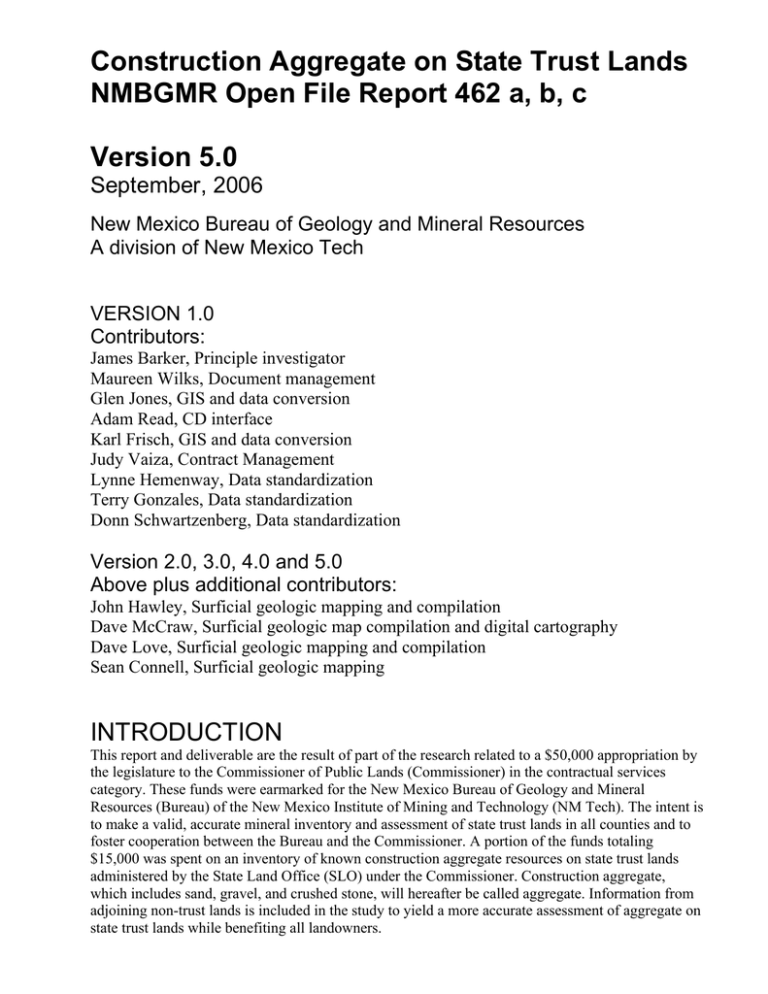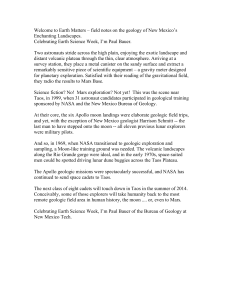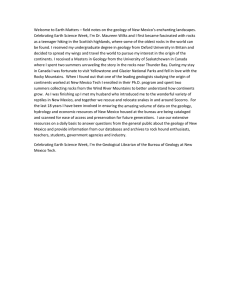Construction Aggregate on State Trust Lands Version 5.0
advertisement

Construction Aggregate on State Trust Lands NMBGMR Open File Report 462 a, b, c Version 5.0 September, 2006 New Mexico Bureau of Geology and Mineral Resources A division of New Mexico Tech VERSION 1.0 Contributors: James Barker, Principle investigator Maureen Wilks, Document management Glen Jones, GIS and data conversion Adam Read, CD interface Karl Frisch, GIS and data conversion Judy Vaiza, Contract Management Lynne Hemenway, Data standardization Terry Gonzales, Data standardization Donn Schwartzenberg, Data standardization Version 2.0, 3.0, 4.0 and 5.0 Above plus additional contributors: John Hawley, Surficial geologic mapping and compilation Dave McCraw, Surficial geologic map compilation and digital cartography Dave Love, Surficial geologic mapping and compilation Sean Connell, Surficial geologic mapping INTRODUCTION This report and deliverable are the result of part of the research related to a $50,000 appropriation by the legislature to the Commissioner of Public Lands (Commissioner) in the contractual services category. These funds were earmarked for the New Mexico Bureau of Geology and Mineral Resources (Bureau) of the New Mexico Institute of Mining and Technology (NM Tech). The intent is to make a valid, accurate mineral inventory and assessment of state trust lands in all counties and to foster cooperation between the Bureau and the Commissioner. A portion of the funds totaling $15,000 was spent on an inventory of known construction aggregate resources on state trust lands administered by the State Land Office (SLO) under the Commissioner. Construction aggregate, which includes sand, gravel, and crushed stone, will hereafter be called aggregate. Information from adjoining non-trust lands is included in the study to yield a more accurate assessment of aggregate on state trust lands while benefiting all landowners. Many of the documents included in this study were scanned into a digital format; other data reside in database files. The scanning process used advanced and proprietary techniques to quickly and economically convert text/graphics to digital Portable Document File (PDF) format. Converting these documents to digital format widened availability of these hard-to-find but still very useful publications. These digital maps and data are very useful in the field when used with a laptop computer and GPS receiver (global positioning system). Later versions of this report and deliverable (starting with 2.0 an including this latest version 5.0) are the result of additional funding to continue the study of construction aggregate on state trust lands. These subsequent versions contain minor additions and corrections to the original dataset; the principle focus of additional work being the Geographical Information System (GIS)- based compilation and development of a detailed, statewide surficial geologic map, based primarily on Dr. John Hawley’s largely unpublished maps and reports—the result of long career working throughout New Mexico. These subsequent versions documented progress on The Surficial Geologic Materials Map of New Mexico compilation effort; which was undertaken by quadrant, proceeding clockwise from the northwest. This current version (5.0) completes the first interim draft of the entire state. However, completion of anticipated revisions to the surficial geologic map following internal and external review will result in a more refined version of the surficial map. That product will be released as a separate publication. This interim data is being released here because of contract obligations and because of public interest as NMBGMR Open File Report-462 (v. 5.0). Users of this data must understand that this remains a work in progress and that portions of this report (particularly The Surficial Geologic Materials Map of New Mexico) will be superseded by later reports and perhaps print publications. CONTRACT HISTORY SLO Contract #01-19; NM Tech Account 29C-USS010 The New Mexico Bureau of Geology and Mineral Resources did a preliminary evaluation of aggregate resources on state trust lands through the collection and collation of existing data. The final report for this phase was transferred in September 2001. The deliverables were an ArcView Project of the state with themes for construction aggregate, geology, land ownership, and others on CDROM. Also included were scans of the NM State Highway Department folios and associated documents. Version 2.0, Version 3.0, Version 4.0 and Version 5.0 SLO Contract #02-30; NM Tech Account 29X-UAY010 The Bureau deliverables under this agreement are in five parts consisting of four preliminary versions of ArcGIS projects representing progress in the development of The Surficial Geologic Materials Map of New Mexico compilation by state quadrant plus an integrated final map incorporating all into a final statewide coverage. The first quadrant, northwestern New Mexico, was delivered in September 2002 and was incorporated into Version 1.0 of the study of construction aggregate on state lands as Version 2.0. Subsequent versions contain data from all prior versions plus the added mineral estate coverage and updates on the surficial geologic map. This product consists of three CD-ROM disks A. NMBGMR OFR-462a contains Geographic Information Systems (GIS) data obtained from these Folios and other data sources concerning Aggregate resources in New Mexico. B. NMBGMR OFR-462b NM State Highway Department folios (PDF format) C. NMBGMR OFR-462c contains GIS data and maps of the Surficial Geology of New Mexico. DATA SOURCES Version-1.0 data include, but are not limited to: • NM State Highway Department data (Regions 1 to 5 plus updates; I-10 and I-25 route studies) • SLO historical lease data • Active mines, mills, and quarries in New Mexico • Base map data from http://rgis.unm.edu Version-2.0 data include, but are not limited to: • Surficial geology of northwestern New Mexico based mainly on Hawley’s unpublished maps and reports • Additions to the state trust lands coverage (now includes both surface and mineral estates) Version-3.0 added: • Surficial geology coverage for northeastern New Mexico Version-4.0 added: • Surficial geology coverage for southeastern New Mexico Version-5.0 added: • The report was expandend from a two-disk CD-ROM set to a three-disk set (see above). • Surficial geology coverage for southwestern New Mexico (completing statewide coverage) • The format of GIS maps was changed from ArcView 3.x/ArcExplorer to ArcMap/ArcReader 9.x. • Revised versions of BLM Public Land Survey System data (PLSS), land ownership, federal mineral ownership, and land grants. • Revised versions of the Mineral Estate of the State of New Mexico (from the NM State Land Office) were included. These data were not incorporated into the ArcMap or ArcReader projects because of registration/projection problems inherent in the data. Use for reference purposes only. NM State Highway Department data The NM State Highway Department folios were produced in the late 1960s to early 1970s. They are a comprehensive statewide assessment of construction aggregate resources. They emphasize resources near roadways compared to remote resources. These folios remain highly useful and are in demand for planning statewide. A limited number were produced and they have become relatively rare. To ensure widespread availability, the folios were scanned and the data placed in a database. Both are available with this report (the scanned folios are on disk b). SLO historical lease data The SLO, in conjunction with a court case in the late 1990s, prepared a list of all state-land leases for construction aggregate. This list included all leases since statehood for which records could be located. These data are included in this report to ensure that this work is readily available and to highlight historical trends in construction aggregate utilization. Active mines, mills, and quarries The current edition of Active Mines, Mills, and Quarries in New Mexico was released in mid-year 2001 and is included with this report. The operations listed are those that reported, as required by law, to the NM Energy Minerals and Natural Resources Division. The data were collated and mapped by the NM Bureau of Geology and Mineral Resources and published in cooperation by the NM State Mine Inspector, both units of NM Tech. About 2/3 of active operations in New Mexico produce construction aggregate, and these data show current utilization of the resource. RGIS Data Basemap data was obtained from the Resource Geographic Information System at UNM (http://rgis.unm.edu). These data sets are in ESRI shapefile format: • • • • • • • • • • • • • • • • • New Mexico Outline Cities/Towns Highways Railroads Surface Water (Perennial) Counties 1:100,000 quadrangle maps 1:24,000 quadrangle maps Metropolitan Areas Indian and Military Reservations Wilderness Areas Wilderness Study Areas US Forest Service Roadless Areas Geology Vents Geology Lines Geology Polygons New Mexico Incorporated Areas Note: Most but not all of the GIS data in this report has associated metadata (*.met files). Surficial Data Surficial-geology coverages were added to the project starting with Version 2.0. These coverages contained several layers conforming to a simplified version of Hawley’s classification scheme (see associated metadata and documentation). Versions 3.0, 4.0 and 5.0 add surficial geology coverage to the northeastern, southeastern and southwestern portions of the state respectively. At version 5.0, the surficial geologic map and data were moved to a separate disk (NMBGMR OFR-462c) because of file-size limitations. SCANNING The scanning process used in Version 1.0 for documents used advanced and proprietary techniques. The documents were scanned in an automated process that quickly and economically converts text/graphics to digital Portable Document File (PDF) format. Converting these to a digital format improved the project by widening the availability of these hard-to-find publications because digital distribution is very efficient and inexpensive, especially for large, long, or numerous documents. PDF is the de facto standard for document delivery on CD-ROM and online. Three types of PDF file exist: Image Only, Image Plus Text, and PDF Normal. We will supply the data in Image-PlusText PDF format. This format has larger files than Image Only but has the advantage that it is both editable (text can be copied), because it has undergone optical character recognition, and searchable while retaining an exact image of the original. The PDF files delivered is easily read using the freeware program Adobe Acrobat Reader available widely on the Internet and on the CD. Acrobat Reader is on the data CD attached to this report for the users convenience. Geographic Information System (GIS) Version 1.0—Shapefiles are provided that can be used in ArcView 3.x, Arc Info, and ArcGIS. We have also provided ArcMap and ArcReader projects of the state with themes for construction aggregate, geology, and land ownership. The main work on the above data was standardization so that these data could be entered into the GIS software. Additional work was needed to ensure that each site had a valid, formatted decimal latitude and longitude. A base map of New Mexico was prepared and the state land grid added. Version 2.0—A shapefile was added for mineral estate ownership. Compilation of the Hawley surficial data entailed that deposit contacts on paper maps be digitized for ArcGIS manipulation. The Hawley data are in three data layers covering northwestern New Mexico. The primary surficial geologic classification is shown on the map. Additional information about the aggregate at a given location is provided by data entered into the associated GIS database. Version 3.0, 4.0 and 5.0 —Compilation of the Hawley surficial data required that deposit contacts on paper maps be digitized for ArcGIS manipulation. The Hawley data are in three data layers (where possible) covering northwestern, northeastern, southeastern and southwestern New Mexico. The primary surficial geologic classification is shown on the map. Additional information about the aggregate at a given location is provided by data entered into the associated GIS database. At version 5.0, GIS projects were migrated to ArcMap/ArcReader 9.x formats rather than ArcView 3.x /ArcExplorer formats that were used in earlier versions. APPENDICES A) State Highway Department Folio—Data standardization The information provided in the folio tables required that an Access-based database be designed to incorporate all information. Data entry forms were developed for the three types of published tables. All data were recorded in the main table. Data standardization personnel entered the data from the printed tables into the database. A total of 58 fields are in the primary table of the database as listed below. A subset of data with no known coordinates was generated so that location could be determined from positions calculated from folio maps, or from other sources in a few cases. Number (Long) PitNumber FormType Owner Surface Owner Subnitted DateSigned DateExpired ProjectNo LeaseNo MapNumber MapName Section NewQQSection QQSection Township Range County Pit Location Formation TimePeriod RockType SourceRock QualityofMaterial Thickness CapThickness BlastingQualities Uniformity Impurities MaterialUnderFm MoistureCondition Vegetation LocalTerrain OverburdenThickness PI EstimatedQuantity ExtensionPossibilities HaultoNearestPoint Royalty LosAngelesWear SoundnessLoss AverageMaxSize Retainedon2Sieve Crushedto 2 1 Half ThreeQuarters No No10 No 0 No80 No100 No200 Plasticity Remarks AcceptFor LabNo B) Issues and Problems • Some points are duplicated. This occurs because the NM State Highway Dept. duplicated data on maps covering more than one district. Data can also be duplicated when an older report shows a prospect and a later report shows a mine. • GIS Data: What is visible depends on the viewer. These shapefiles can be viewed on the free GIS viewer ArcReader available from ESRI (http://www.esri.com/software/arcgis/arcreader) or with the more functional commercial ESRI ArcMap 9.1 (or later) or ArcView 9.1 (or later) software. GIS data from the State Land office included on the CD are listed below: • • • Highway Dept. Pits Town Lot poly Townpoly Note: Some of the GIS data in this report does not have associated metadata.






